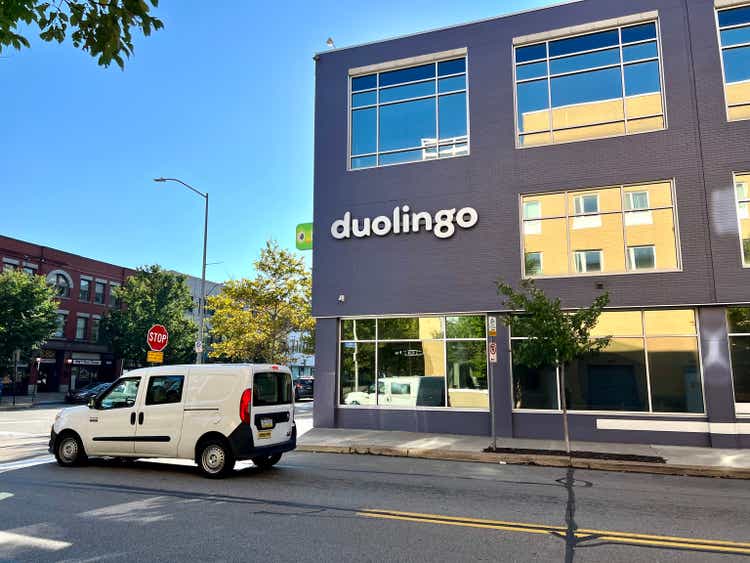Introduction
Over the last few months, I have advised investors to avoid unprofitable growth companies as the era of profitless prosperity winds down. I believed there was substantial downside in WeWork (WE), GitLab (GTLB) and Guidewire (GWRE) even if they attained a reasonable profitability margin.
Today, I offer a fundamental value perspective on fast-growing language company Duolingo (NASDAQ:DUOL). I find that it is not as overvalued as many other tech stocks in the market, especially if it can successfully increase its margins to the 10% level. I would not bet my mortgage on that happening (especially given current refinancing rates), but if you are a buyer of the stock, that would not be an unreasonable assumption to make.
Company background
Duolingo was founded in 2011 and is headquartered in Pittsburgh, PA. The company has done an admirable job of becoming the world’s most downloaded education app. It appears to be an effective way to learn a new language, offering support for 40+ languages. Users can practice vocabulary, grammar, pronunciation and listening skills. The company has a freemium model with 50 million monthly active users. Users can upgrade to a premium version without advertising and more features. The company currently has more than 3 million paid subscribers.
After being initially funded by venture capital, the company went public on the Nasdaq in 2021. Sadly, the company has always been unprofitable, with modest losses increasing once the company got the public’s money.
Duolingo Q2 financial overview
For the latest quarter ending June 30, 2022, the company generated $88.4 million in revenue, up 50% YoY. Operating income was a loss of $15 million (-17% operating margin), and net income was a loss of $15 million or $0.38 per share.
The company currently has 39.6 million shares and a market capitalization of $3.1 billion. It has no debt and $591 million of cash. It thus has an enterprise value of $2.5 billion, amounting to 7x its annual revenue.
Analysts expect the company to continue growing rapidly, with its losses maintained. The company’s guidance is for approximately $364 million in revenue for this year and a little above break-even on adjusted EBITDA. I believe the company’s reliance on this metric indicates it does not have a credible plan towards GAAP profitability and would prefer to have investors ignore expenses like stock compensation.
DUOL stock valuation and recommendation
To be clear, the company’s value is close to zero if it cannot achieve and maintain GAAP profits. However, I believe that at some point, aided by a falling stock price, it will make an attempt to cut costs and become profitable. I am modeling a 10% GAAP operating margin in the long term.
A 10% margin on $467 million of expected 2023 revenue (28% growth over this year) would mean annual profit of $$47 million. I would assume a 15% tax rate, lower than the statutory rate, due to some net operating losses that can shield taxes. Thus, the company would generate $40 million in after-tax income or $1 per share. I would apply a generous 50x multiple in recognition of its growth rate, to arrive at a per share value of $50 for the business. Adding back $15 of cash per share on the balance sheet would result in fair value for the shares of $65. Thus, I believe there is 15% downside from the current share price of $78.
This level of downside is considerably less than that I have identified for other profitless stocks in the market, and so I would not recommend a short position at this price, though the proposition becomes more attractive if the stock were to move higher. I would not recommend a long position unless you believe that the company can increase its operating margin to the 15% range, or is likely to be acquired by another firm.
I am not considering the company’s recently announced acquisition of Gunner, a design and animation studio, pending information on how it would affect the company’s financials. I do not believe it will have a material impact on the valuation.
External ratings
Seeking Alpha’s quant rating appears to agree with my analysis. It has a composite rating of 2.8, equating to a hold, with an F for valuation and C for profitability, offset by A’s for growth and momentum. Not surprisingly, Wall Street analysts are more positive, with a combined rating of 4.0, representing a buy. Like for most stocks this year, their price targets have been following the stock lower.
Conclusion
A position in Duolingo (DUOL) is best avoided at the current price. If you forced me to choose a path, I would say short the stock as an offset to long positions in your portfolio. Puts could be sold to generate some premium against a short position. The short interest is low at 5% of outstanding shares, denoting a low risk of a short squeeze.

bgwalker/iStock Unreleased via Getty Images


Be the first to comment